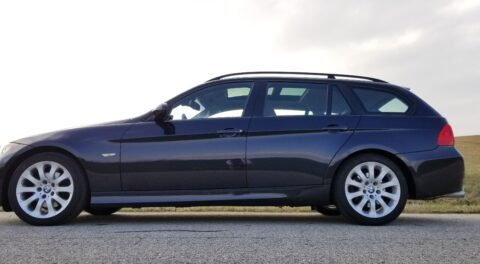Eight weeks and two days after Bring a Trailer (BaT) accepted my friend Chris’ 1972 2002tii (her deceased husband’s original-owner car), an auction specialist finally sent me a draft description.
Imagine my joy.
I’ve made no bones about my frustrations with BaT. Note that don’t hang out there looking at car porn or commenting on auctions, I’ve never bid on or much less bought a car there, and technically I haven’t sold one of my own cars there yet, but I have had two cars on the site. The first was a ’73 2002tii that I represented for a friend a couple of years ago. It was a pretty shiny example in Colorado orange, with some visibly misaligned panels and some odd aftermarket interior touches, but it photographed well and had a five-speed and A/C. It sold for $38,750. The second one was my own car—”Hampton” the 49,000-mile 2002—that failed to meet reserve. In both cases I used the following recipe:
- Write up a lengthy “warts and all” description.
- You can’t use that description for BaT—they instead force you to enter information on condition, originality, recent repairs, and needed work into text fields in a form—but it forces you to have everything at the ready.
- Wait for BaT to send you their draft description.
- Grit your teeth, gag, and bang the table a few times when you see how horrible the draft description is, then try to get them to correct anything that’s flat-out wrong.
- When the auction goes live, post your complete description as the first comment.
Before I tear too much into BaT (again), I should say that they treated me very fairly with Hampton. The paperwork backing up the car’s 49,000-mile provenance wasn’t as thick as one would like to see it, but they bought off on it, advertised it as a 49,000-mile car, and I was grateful and said so on their site.
But fundamentally, whenever I have to use BaT, it drives me crazy.
It’s not their lawyer-driven overly-cautious descriptions that make them allergic to phrases like “no rust” or “needs nothing” or “rare color” and instead relies heavily on modifiers such as “reportedly” or “the seller states” to insulate the site from liability.
It’s not their oft-lampooned dry “house voice” that includes overused phrases like “power is delivered to the rear wheels,” which always makes me want to complete it with “by Fedex Ground, unless you have Amazon Prime and pay $2.99 in which case power arrives first thing in the morning.” I get the “house voice” thing. I worked at Bentley Publishers for about a year and a half, and in addition to the two Hack Mechanic books I wrote for them, contributed to their F30 3 Series manual. My sections needed to be indistinguishable from those written by the other in-house writers. House voice has a place.
It’s not the fact that they present themselves as a curated auction site when, in fact, the Bring a Trailer process does not include a BaT employee physically inspecting your car.
It’s not the social media aspect where they crowdsource expertise—and, to be fair, often absolutely indispensable first-rate expertise—from people who they don’t pay.
No, what drives me absolutely crazy about BaT’s descriptions is their rejection of one of the most basic rules of writing—that paragraphs should contain sentences that pertain to the same thing. If you want a general description of a particular model car (e.g., “A BMW 2002 is a two-door sedan built from 1968 through 1976 with a two-liter four-cylinder engine, front disc and rear drum brakes, and four-wheel independent suspension”), write it and put it in a paragraph. The overall condition of the car being sold should be another paragraph. Ditto with modifications, recent repair work, and needed work. Instead, the BaT format mixes these things together, resulting in the following actual word-salad-like paragraph from their draft description for Chris’ car:
“The car is finished in metallic blue, and various body panels were repainted between 1987 and 2003 following corrosion repair. Features include a polished fuel-filler cap, bright window and beltline trim, chrome bumpers with overriders, round taillights, and pop-out rear side windows.”
When I commented to the auction specialist that he was mixing issues of condition of this particular car (the “bright window and beltline trim” was an excerpt from a highly-detailed description I sent them of the state of the car’s chrome) with the chrome bumpers and round taillights that all ’68 to ’73 2002s have, and with the pop-out rear side windows that all 2002s have, the auction specialist replied that this was part of the BaT format (they did move the “polished fuel-filler cap” to the end of the paragraph when I complained that talking about something as trivial as the gas cap so close to the beginning of the auction was bizarre).
There were other strange mashups and separations as well. The recent work I’d done on the car was distributed across three paragraphs instead of simply being listed in one. When I requested that things be organized into paragraphs a different way, the auction specialist’s response talked about BaT format and style and directed me to other examples of 2002 auctions. I can see how their descriptions move from a general paragraph to body to brakes, wheels, and suspension to interior to drivetrain, but it creates this gobbledygook where a 2002 newbie can’t tell if, for example, round taillights and pop-out rear side windows are “features” of this car, of some 2002s, or of all 2002s. As my Facebook friend Aaron Robinson said, “They actively discourage proper composition in favor of passive-voiced plausible deniability. Their ads are mealy-mouthed Mad Libs designed to avoid actually stating anything categorical other than ‘This is a car. It is old. It is said to be composed of car parts manufactured by a manufacturer.'”
So the answer to most of my requested changes was “no.” Other requests that they denied included:
- Not listing the color of Chris’ tii as Fjord because the car had been repainted and “Fjord” wasn’t explicitly listed on the invoice. That’s why it says “finished in metallic blue” in the draft description paragraph instead. (I’m still gently pressing to change this.)
- Not listing the car’s replacement engine as “factory” even though there’s a factory replacement engine brochure in the repair records, the engine was installed at a dealership, and there’s no VIN stamped on the block, as I believe is the case with a factory replacement engine. (The reply was “We do not use terms such as ‘factory’ when it comes to replacement parts such as the engine.”)
The auction specialist, however, does appear amenable to my request to include “the bad stuff” (the “snorkel” nose, the non-factory welds where it’s attached, and the gratuitous use of gravel-guard coating under the hood and on portions of the undercarriage and a waxy Ziebart-like coating in the trunk) up near the beginning of the description to help inoculate the auction from folks doing the Invasion of the Body Snatchers screech when they see them. So at least I got that. (I must be the only person in BaT history to request that they put more of “the bad stuff” not only in the description, but right up front.)
It just kills me that I had to wait nearly two months in order to receive something that wouldn’t pass muster in a middle school English class.
So, why put up with this?
Because I’m acting as Chris’ agent, I have a fiducial responsibility to her, and BaT does have a documented track record of producing good sales results.
Really, as a seller, Bring a Trailer is like the crazy partner you don’t want to break up with because the sex is so good.
Hopefully the auction will go live in the next few days.—Rob Siegel
Rob’s new book, The Best of The Hack Mechanic, is available here on Amazon, as are his seven other books. Signed copies can be ordered directly from Rob here.





















